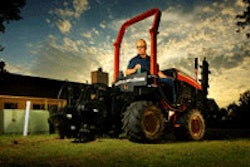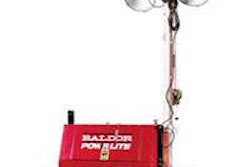 Myron Mullett’s gut told him there had to be an easier way. As owner of Westcliffe, Colo.-based Mullett Excavating, he had received a multiyear military contract to lay gravel on 90 miles of road in nearby Fort Carson. The 32-foot wide road, designed in part to handle tanks, required 4 inches of gravel on each side and a 2-percent crown. Mullett figured the tight-tolerance job would call for driving three rows of grade stakes: one on each side and one in the center. He wasn’t in the mood to drive all those stakes.
Myron Mullett’s gut told him there had to be an easier way. As owner of Westcliffe, Colo.-based Mullett Excavating, he had received a multiyear military contract to lay gravel on 90 miles of road in nearby Fort Carson. The 32-foot wide road, designed in part to handle tanks, required 4 inches of gravel on each side and a 2-percent crown. Mullett figured the tight-tolerance job would call for driving three rows of grade stakes: one on each side and one in the center. He wasn’t in the mood to drive all those stakes.
So he began to wonder: Would a box blade attached to the front of a dozer blade eliminate the need for stakes?
Well, no, everyone told him when he started asking around. He’d never be able to keep the gravel from going under the sides and throwing off the grade.
But Mullett still thought the idea had merit, so he tinkered with a snowplow blade, putting adjustable skids on each end, and then attaching it to an old dozer. He also put a plow device on each side of the blade that directed the gravel underneath the blade and away from the skids. Using the down force of the dozer, the skids rode on the subgrade, keeping the attachment at grade, allowing the blade edge to screed the gravel to grade as it passed underneath.
The make-shift set up worked, laying gravel at the required tolerances and maintaining grade, all without stakes. “Not only did we do the project faster, our end product was much better,” Mullett says.
Beyond a stakeless operation, Mullett had another impetus with his experimentation: accurate gravel placement. “If a contractor’s being paid for 8 inches of gravel, he only wants to put down 8 inches,” Mullett says. “Since this stays on the subgrade, if your subgrade is right, it will place the correct amount of gravel.”
Mullett knew he was on to something, so after the first job he created a from-scratch fixed 18-foot prototype his company still uses. “We tried to bury it in gravel to see how much we could do in one day, using 20 belly dumps and hauling three loads per hour,” he says. “We laid down almost 18,000 tons of gravel in 10 hours straight.”
These prototypes lead to AggreScreed, an attachment Mullett is marketing through his fledgling company, TerraTec Industries.
AggreScreed at a glance
Host machine: 125- to 200-net-horsepower dozer with straight, six-way blade
Attach/detach time: Up to 30 minutes
Width: 16 to 24 feet, extending in 1-foot increments
Height: 4 feet
Weight: 6,000 pounds
Depth of gravel: Up to 15 inches, adjustable at any increment
Crown: Up to 3-½ percent
One key to AggreScreed is its adjustability. The blade width, side skids and the blade edge are all adjustable. The width can change from 16 to 24 feet in 1-foot increments. In the 24-foot position, the attachment is capable of laying down gravel to spec, complete with a crown, in one pass down the middle of a standard two-lane road.
 Mullet credits the plow device on each side of the blade as “the reason the whole thing works.” It keeps gravel from
Mullet credits the plow device on each side of the blade as “the reason the whole thing works.” It keeps gravel from
AggreScreed’s width is adjusted by 24 bolts – 12 on each side – in a process that takes 40 minutes manually. Once the bolts are removed, the attachment’s hydraulic system, controlled by a box mounted in the dozer cab, extends or retracts the blade to a preset position. Reattach the bolts into the pre-drilled holes and you’re ready for the next job.
Adjustability turned out to be the biggest design challenge, since Mullett sought an economical solution that didn’t take a lot of time to change. Because the hydraulics are used only when adjusting the width and skid heights, Mullet used a separate hydraulic system for AggreScreed rather than tapping into the host dozer’s system.
“… between the decrease of labor and the accuracy of gravel placement, the attachment could be paid for after placing 10 miles of road.”
Myron Mullett
The heights of the skids on each side also adjust, up to 15 inches. Mullett figures in an additional amount for compaction, depending on the type of aggregate used.
By adjusting the slotted blade edge up or down the attachment can achieve up to a 3-½-percent crown.
AggreScreed’s width limits it to being used for uncompacted gravel and light materials. One contractor approached Mullett about using it for a 1-inch dirt pass. “I think it would work for that small of a pass, but it’s not for pushing dirt,” he says.
Mullett says between the decrease of labor and the accuracy of gravel placement, the attachment could be paid for after placing 10 miles of road. “At $12 to $14 a ton, the savings in gravel costs alone can make a big difference,” he says. In addition to truck drivers, the operation requires two people – the dozer operator and someone to operate an auxiliary machine to reposition any misplaced gravel.
Coming soon
A natural add-on will be GPS and laser, which Mullett plans to offer in the near future. Such add-ons, however, will add significantly to AggreScreed’s anticipated $65,000 cost.
Two other models are also in the planning stages, one that would adjust from 10 to 15 feet wide, and a fixed blade for skid steers. “We see the skid steer product used for creating trails or large shoulders,” Mullett says. And he envisions a trailer capable of hauling the 6,000-pound attachment at full width, so it won’t have to be retracted for transport.
Mullett’s anxious to see what uses other contractors can make of the AggreScreed. “Let anyone use his or her imagination when it comes to applications,” he says. “Right now, it’s for laying gravel, but who knows what someone might come up with? v
 (Left to right) Myron Mullet and Tim Lorenzen
(Left to right) Myron Mullet and Tim Lorenzen
Manufacturing was not Mullett’s initial goal. He first asked the manufacturer of the snowplow he had converted into the first AggreScreed prototype if the company had any interest in the idea. It said no. He also searched for any similar products, and failed to find any. He finally came to the conclusion it would be best to take the product to market himself. That route would require help.
Mullett applied for the AggreScreed patent more than four years ago, a process full of delays and discouragement. This past November, however, the U.S. Patent Office told him his patent had been approved.
Mullett used the patent process time to not only improve his product but also line up how he would get the attachment to market, knowing the effort would require talents outside of his skill set. About two years ago, a mutual friend introduced him to Tim Lorenzen, now TerraTec Industries’ chief operating officer. Mullet calls Lorenzen’s background in manufacturing and sales a natural for his new company. Together, they have lined up an industrial designer, fabrication shops, and worked with a local marketing firm to create the company and product name, logo, Website and promotional materials.
One of their key marketing pieces will be a DVD showing the attachment in action. “Once contractors can see what it does, they’ll understand,” Mullett says.
For more information, go to www.terratecind.com.











